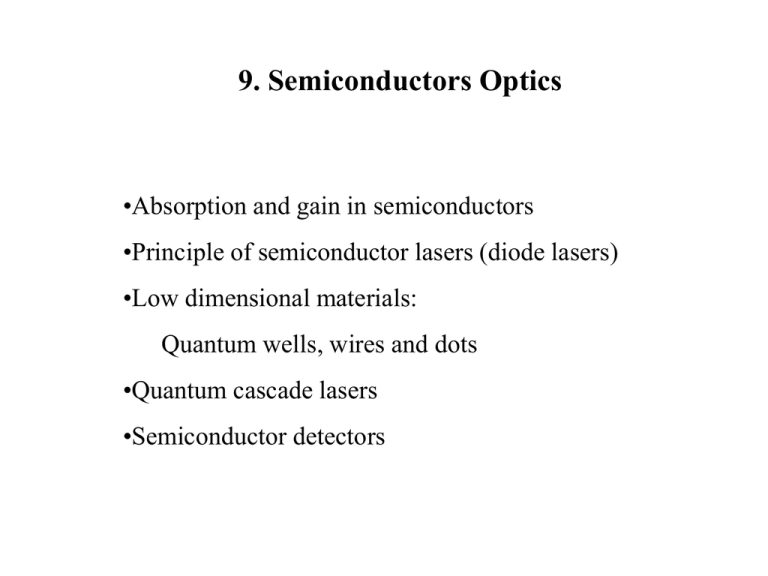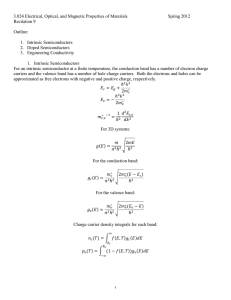9. Optical Processes in Semiconductors
advertisement

9. Semiconductors Optics •Absorption and gain in semiconductors •Principle of semiconductor lasers (diode lasers) •Low dimensional materials: Quantum wells, wires and dots •Quantum cascade lasers •Semiconductor detectors Semiconductors Optics Semiconductors in optics: •Light emitters, including lasers and LEDs •Detectors •Amplifiers •Waveguides and switches •Absorbers and filters •Nonlinear crystals The energy bands One atom Two interacting atoms N interacting atoms Eg Insulator Conductor (metals) Semiconductors Doped semiconductor n-type p-type Interband transistion h E g h E g nanoseconds in GaAs Intraband transitions < ps in GaAs n-type UV Optical fiber communication GaAs ZnSe InP Bandgap rules The bandgap increases with decreasing lattice constant. The bandgap decreases with increasing temperature. Interband vs Intraband Interband: C Most semiconductor devices operated based on the interband transitions, namely between the conduction and valence bands. The devices are usually bipolar involving a pn junction. V Intraband: A new class of devices, such as the quantum cascade lasers, are based on the transitions between the sub-bands in the conduction or valence bands. The intraband devices are unipolar. Faster than the intraband devices C Interband transitions Conduction band E 2 k E (k ) 2mc k Valence band 2 E Conduction band 2k 2 E (k ) 2mc Eg k Valence band Examples: mc=0.08 me for conduction band in GaAs mc=0.46 me for valence band in GaAs Direct vs. indirect band gap k GaAs AlxGa1-xAs x<0.3 ZnSe k Si AlAs Diamond Direct vs. indirect band gap Direct bandgap materials: Strong luminescence Light emitters Detectors Direct bandgap materials: Weak or no luminescence Detectors Fermi-Dirac distribution function f (E) 1 e ( E EF ) / kT 1 E EF 0.5 1 f(E) Fermi-Dirac distribution function f (E) 1 e ( E E F ) / kT For electrons 1 1 f (E) For holes E kT EF 0.5 1 f(E) kT=25 meV at 300 K Fermi-Dirac distribution function f (E) 1 e ( E E F ) / kT For electrons 1 1 f (E) For holes E f(E) kT EF kT=25 meV at 300 K 0.5 1 E Conduction band Density of States 1 2mc (E) ( 2 ) E 2 Valence band E Conduction band (E) Valence band For filling purpose, the smaller the effective mass the better. 1 2mc ( 2 ) E 2 E Where is the Fermi Level ? (E) Conduction band n-doped Intrinsic Valence band P-doped 1 2mc ( 2 ) E 2 Interband carrier recombination time (lifetime) ~ nanoseconds in III-V compound (GaAs, InGaAsP) ~ microseconds in silicon Speed, energy storage, E Quasi-Fermi levels E E Ef e Immediately after Absorbing photons Returning to thermal equilibrium Ef h (E) 1 2mc ( 2 ) E 2 E fe # of carriers EF e x EF h (E) 1 2mc ( 2 ) E 2 = E Condition for net gain >0 EF c Rabsorption v f ( Ev ) c ( Ec )(1 f ( Ec )) Eg Remission v (1 f ( Ev )) c ( Ec ) f ( Ec ) Rnet Remission Rabsorption Rnet ( EFc EFv ) E g EF v P-n junction unbiased EF P-n junction Under forward bias EF Heterojunction Under forward bias Homojunction hv N p Heterojunction waveguide n x Heterojunction 10 – 100 nm EF Heterojunction A four-level system 10 – 100 nm Phonons Absorption and gain in semiconductor E Conduction band g (E) Valence band Eg E E Eg 1 2mc ( ) E 2 2 Absorption (loss) g Eg Eg Gain g Eg Eg Gain at 0 K g EFc-EFv Eg EFc-EFv Eg Density of states Gain and loss at 0 K g Eg EF=(EFc-EFv) E=hv E Eg Gain and loss at T=0 K at different pumping rates g EF=(EFc-EFv) Eg E N1 N2 >N1 E Eg Gain and loss at T>0 K laser g Eg N1 N2 >N1 E E Eg Gain and loss at T>0 K Effect of increasing temperature laser g Eg N1 N2 >N1 E At a higher temperature E Eg A diode laser Larger bandgap (and lower index ) materials <0.2m p n <0.1 mm Substrate Cleaved facets Smaller bandgap (and higher index ) materials <1 mm w/wo coating Wavelength of diode lasers • Broad band width (>200 nm) • Wavelength selection by grating • Temperature tuning in a small range Wavelength selection by grating tuning A distributed-feedback diode laser with imbedded grating <0.2m p n Grating Typical numbers for optical gain: Gain coefficient at threshold: 20 cm-1 Carrier density: 10 18 cm-3 Electrical to optical conversion efficiency: >30% Internal quantum efficiency >90% Power of optical damage 106W/cm2 Modulation bandwidth >10 GHz Semiconductor vs solid-state Semiconductors: • Fast: due to short excited state lifetime ( ns) • Direct electrical pumping • Broad bandwidth • Lack of energy storage • Low damage threshold Solid-state lasers, such as rare-earth ion based: • Need optical pumping • Long storage time for high peak power • High damage threshold Strained layer and bandgap engineering Substrate Density of states 3-D (bulk) (E) E E Low dimensional semiconductors When the dimension of potential well is comparable to the deBroglie wavelength of electrons and holes. Lz<10nm 2- dimensional semiconductors: quantum well Example: GaAs/AlGaAs, ZnSe/ZnMgSe Al0.3Ga0.7As GaAs Al0.3Ga0.7As E For wells of infinite depth En n 2 2mc L2z 2 2 (E ) constant n 1,2,.... E2 E1 2- dimensional semiconductors: quantum well E2c 2 2 Enc n 2me L2z 2 n 1,2,.... E1c E1v E2v 2 2 Env n 2mh L2z 2 n 1,2,.... 2- dimensional semiconductors: quantum well E E2c E1c E2v E1v (E) 2- dimensional semiconductors: quantum well T=0 K g E2c E1c E2v E1v N0=0 N1>N0 N2>N1 2- dimensional semiconductors: quantum well T=300K g E2c E1c E=hv E2v E1v N0=0 N1>N0 N2>N1 2- dimensional semiconductors: quantum well Wavelength : Determined by the composition and thickness of the well and the barrier heights g E2c E1c E=hv E2v E1v N0=0 N1>N0 N2>N1 3-D vs. 2-D T=300K g 2-D 3-D E2v E=hv Multiple quantum well: coupled or uncoupled 1-D (Quantum wire) (E) 1 E Eg E Quantized bandgap Eg 0-D (Quantum dot) An artificial atom ( E ) ( E Ei ) E Ei Quantum cascade lasers



